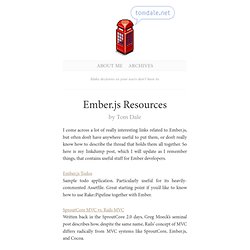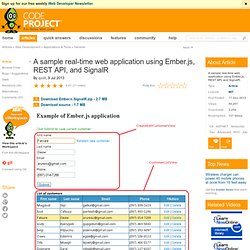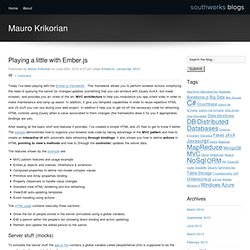

Ember.js Resources : Tom Dale. I come across a lot of really interesting links related to Ember.js, but often don’t have anywhere useful to put them, or don’t really know how to describe the thread that holds them all together.

So here is my linkdump post, which I will update as I remember things, that contains useful stuff for Ember developers. Fiddle: Problem in View and Controller binding. Fiddle:Automatic View and Controller Binding. Addyosmani/todomvc. Sh4n3d4v15/ember-todos. Ember.js Live Collections « Thomas Reynolds. Ember.js Live Collections If you're writing a client-side application, there are two common tasks you can expect to perform.

First, modern web applications are expected to show updated information as quickly as possible without a full page reload. (Think about Twitter or Facebook: as you're reading the updates, newer updates continue to arrive at the top of the page.) Second, you'll be sending the current user's updates to everyone else's streams. You can probably imagine how often you'll need to implement these patterns: mail clients, chat rooms; anything that updates, really. Over the weekend, my friends at Bocoup posted an article called Backbone.js Live Collections which discussed how to use Backbone.js1 to poll Twitter for new tweets and update a list of those tweets on the page.
Back? Assuming that Bocoup simply chose Backbone.js for familiarity's sake, I glibly summed up the article as "In other words, use Ember.js :-p" and ruffled more feathers than I intended. App Template View. A sample real-time web application using Ember.js, REST API, and SignalR. Introduction Ember.js is a powerful JavaScript MVC framework to create complex web applications that eliminates boilerplate and provides a standard application architecture, it supports UI Bindings, Composed Views, Web Presentation Layers, and plays nicely with others.

In order to create a real-time interaction web application, I add a SignalR hub and REST service with ASP.NET MVC. MVC Basics The purpose of MVC pattern is to separate concerns of view, model, and controller. The model is where data is kept, the view describes the presentation of application, and the controller acts as the link between the model and the view. This is a Ember.js's MVC implementation, client side part There is another important concept in Ember.js, that is Router or StateManager, it works mostly like ASP.NET MVC Route, but in client side. Set up project. Ember.js - List DataBinding - The Software Simpleton. I’ve been hacking away on quite a detailed results page that uses Ember.js and Handlebars templating to render html on the client when it receives JSON objects from a websocket connection on the server.

This turned out to be much more difficult than I first envisioned and I thought I would blog about it in order to help anybody else who struggles with some common problems. If anybody with greater Ember knowledge than my own can point to a better way then please leave a comment below. Scenario Below is a screen capture of what I finally ended up with. Each row in the table displays the company details that are extracted from a website screen scraping search operation. Enter the Ember.ArrayProxy One of Ember’s strengths is its excellent databinding support and out of the box, it comes with the Ember.ArrayProxy. It is worth noting that you might also see the ArrayProxy out in the wild called the ArrayController. Below is how my extended ArrayProxy ended up: Problem 1 – Numbering the results or. Playing a little with Ember.js.
Today I’ve been playing with the Ember.js framework .

This framework allows you to perform browser actions simplifying the need of querying the server for changes/updates (something that you can achieve with jQuery AJAX, but made simpler), and provides you an -state of the art- MVC architecture to help you modularize you app (client side) in order to make maintenance and ramp up easier. In addition, it give you template capabilities in order to reuse repetitive HTML and JS stuff you can use during your web project.
In addition it help you to get rid off the necessary code for refreshing HTML controls using jQuery when a value associated to them changes (the frameworks does it for you if appropriates bindings are set).After reading all the basic stuff and features it provides, I’ve created a simple HTML and JS files to get to know it better.